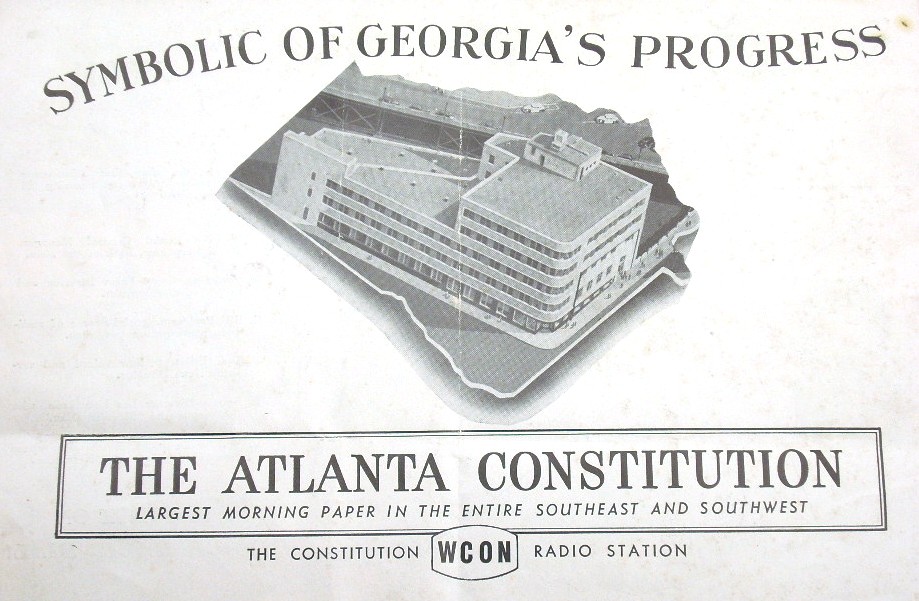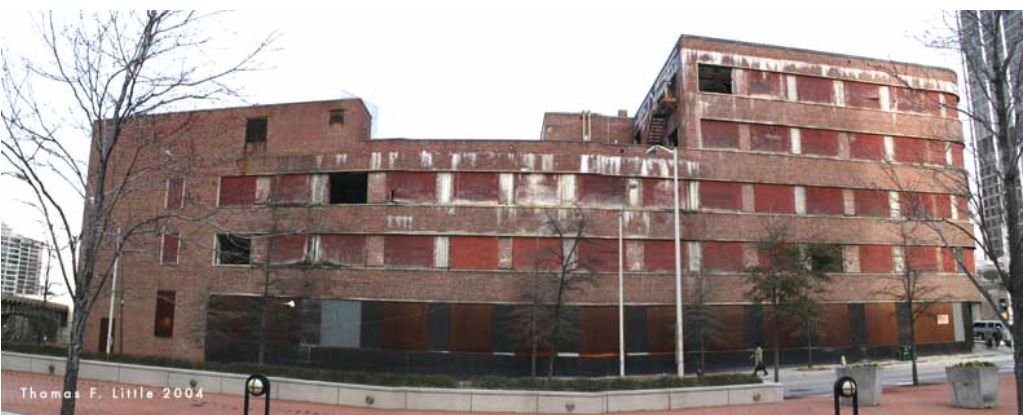 Atlanta Constitution Building, 1948-1953. (Special Collections Department, Georgia State University Library) Atlanta Constitution Building, 1948-1953. (Special Collections Department, Georgia State University Library) A CONTEXT FOR THE CONSTITUTION BUILDING The 1940s were a considerable period of growth in Atlanta. In the years leading up to World War II, the downtown area (roughly defined by the corridor of blocks stretching from North Avenue south to Memorial Drive) continued to grow as the city's major commercial and business district. At the center of this growth were the blocks straddling the railroad gulch, also referred to as the “Heart of Atlanta” due to their proximity to the “Zero Mile Post” which marked both the Southeastern terminus of the Western and Atlantic railroad and the city's earliest settlement. Throughout the first half of the 20th century, the area held its place as a civic center. New development in West End and an increase in urban housing density from multiple projects by the Works Progress Administration contributed to the area’s success. Shops and business along Forsyth, Whitehall, and Mitchell Streets continued under the period of Jim Crow legislation and represented a crossroads for many white and black residents of Atlanta. Atlanta's two train stations were the source of much of the district’s vitality. The railroad boom from the 1920s left its mark throughout the city, most notably the eight trunk lines coming under the viaducts to the Union (constructed 1930) and Terminal (constructed 1905) Stations. Terminal Station, located at the intersection of Spring and Mitchell Streets, served the Central of Georgia, Atlanta & West Point, Seaboard, and Southern rail lines. Passengers from near and far walked down Mitchell Street to shop at the many stores on the southern side of the gulch, including Rich's, Bass's and the Kress ten-cent store. The Central of Georgia line promoted “Rich's Shoppers Specials” to entice riders into the city. During the years of World War II, the Five Points intersection was the rallying point for bond drives and other public demonstrations, as it had been during the previous war. The commercial district also provided entertainment and distraction for GIs on leave to the city. After the war, and as GIs returned, the city rebounded from its wartime rationing of goods and services and assumed an even greater vitality. Broad Street was known as a printing street and was home to many of the city's journals, including the Atlanta Constitution, the Atlanta Journal, Christian Index, Sunday Gazetteer, Sunny South, Weekly Post, as well as several printing firms and binderies. In the first week of 1948, the Atlanta Constitution moved from its location next to Rich's Department store to a new facility across the street. It was the first building designed expressly for a newspaper in Atlanta since the Constitution's previous building opened in 1884. Conceived at the end of an era, the design combined a range of details and expressed a turning point in American architecture. The façade's horizontal bands of windows, curved corners, and sleek stone sheathing contributed to the streamlined aesthetic popularized by the Art Moderne style. But the building's dynamic relation to its triangular site and the continuation of the brick banding throughout each elevation bore the influence of both European Modernism and the progressive designs of Frank Lloyd Wright, notably the widely acclaimed Johnson Wax Administration Building (1936-1939). The significance of the new building was underscored during construction in 1947 when the newspaper's reporters ceremoniously placed pennies in the building's wet concrete. The building's cost, reported as $3,000,000, was a sizable sum for the time. Expenses for the modern plant included “new presses, steel desks, marble corridors and every mechanical contrivance for publishing a modern newspaper in the shortest possible time.” Additionally, WCON, the Constitution's new radio station, was located on the top floor of the building. Retail space occupied the building's sloping base level. Windows located along the Alabama Street sidewalk provided the public a view of printing presses located below street level. Upon moving in, Editor Ralph McGill expressed his desire that the Constitution's prestige should grow to match its new home. After relocation of most of the offices to the new facility, local artist Julian Harris began work on a sculptured 72-foot mural above the building's main entrance along Forsyth Street. Harris carved the sculpture in situ, working daily on a scaffold high above the sidewalk. The project lasted over a month and provided a unique live display of an artist at work. The design, developed over the course of a year, recorded the history of the newspaper and depicted reporters, photographers, and printers at work. Also constructed during the same period was the Rich's Store for Homes. Constructed opposite Rich's main building and adjacent to the Constitution Building, the new store capitalized on the post war demand for houses and provided a wide array of furnishings and domestic goods. The dislocation of the new building inspired the construction of an innovative four-story steel and glass bridge over Forsyth Street to connect the two stores. Dubbed the “Crystal Bridge,” and designed by the Atlanta firm of Toombs and Creighton, it is regarded as one of the first Bauhaus-inspired designs in the South. Transportation improvements continued to affect the downtown district. Begun in 1949, the development of a master urban plan led to the construction of the Metropolitan Expressway System to link the inner city with the national system of interstate highways. In addition, a commercial expansion was planned for downtown, but little progress was made by the end of the year. Such results became symptomatic of the growth trend towards the suburbs. By 1952, through annexation, the city limit had grown to an area three times its size in 1950. During this period, home construction soared in Atlanta's outlying areas and the number of autos surpassed 150,000; each reflecting an enormous shift in personal mobility and residential options. In 1950, James C. Cox bought the Constitution and merged it with the Journal under the name of Atlanta Newspapers, Inc. Although news and editorial operations of the two newspapers were kept separate, the change did result in the consolidation of many operations, leading to Georgia Power Company’s leasing of the building. The building achieved a new significance as the company’s main office and the location where many Atlantans paid their electric bills. In 1953, Atlanta was still the busiest railroad city in the south, servicing 83 passenger trains a day. However, as the expressway neared completion in 1955, daily passenger traffic reduced to 58 trains. The threat to downtown's commercial district was most evident in the 1956 plans for a new shopping mall in the burgeoning area of Buckhead. Opened in 1959, Lenox Mall provided for the exodus of Atlanta residents outside the historic city limits, and as a result, the downtown business district began to suffer. Construction activity did continue downtown, primarily limited to new office space. In 1957, an expansion of the capital complex was begun, and in the following year the Fulton National Bank moved into their 25-story tower-the tallest constructed since the William Oliver Building in 1930. As the center of commercial activity moved northward in the 1960s and 70s, Plaza Park and the rest of the business district to the south of the gulch fell into neglect. In 1960, Georgia Power vacated the Constitution Building and was the last long-term occupant. Further signaling the abandonment of the area, in 1972 both of Atlanta's downtown train stations were demolished, marking the end of private passenger service as AMTRAK took control of the diminished rail lines. During the following two decades, substantial changes would occur: Businesses move further north, suburban office parks grow in significance, and intercity rail service declines. In the immediate area, the once vibrant shopping district is now mostly a memory. The new Sam Nunn Federal Center now occupies the former Rich’s store, the MARTA Five Points station serves to connect two main train lines, and the nearby Underground Atlanta development continues to search for a successful mix of entertainment and shopping. Studies for a multi modal passenger terminal to serve planned commuter rail lines, AMTRAK, and bus service have focused on properties adjacent to the MARTA station for a number of reasons. Existing rail lines, access to MARTA, and the expanse of valuable undeveloped property known as the “gulch” have contributed to this focus. These plans assume demolition of the Spring Street Viaduct and the Atlanta Constitution Building would be required to make way for a new terminal structure, never considering adaptive use of the historic structures as an alternative. Long-range plans have proposed dense development in and over the historic “gulch.” Ultimately, plans for a new multimodal terminal remain unfunded. Currently funded plans include only one commuter line (a 26-mile Lovejoy-Atlanta line), planned to start operation in 2006. Associated with this is a pedestrian link allowing passengers to walk below Forsyth Street to the MARTA station. Although these plans assume demolition of the Constitution Building, they do not include construction of a terminal as anticipated in the 1995 Memorandum of Agreement. Jon Buono, Thomas Little ©2004 DOCOMOMO US, Georgia Chapter, Inc.
8 Comments
Ann Ladenberger
7/12/2017 01:56:09 pm
Art Moderne architecture is cool, and Art Moderne buildings are not terribly common. I dearly hope this building is restored for current usage and for posterity.
Reply
8/3/2022 05:34:34 pm
Edirne ECA servisi için hemen websitemize göz at! https://www.edirneklimaservisi.com/edirne-eca-servisi/
Reply
12/19/2022 05:59:20 pm
İnstagram takipçi satın almak istiyorsan tıkla.
Reply
1/4/2023 07:19:05 pm
100 tl deneme bonusu veren siteleri öğrenmek istiyorsan tıkla.
Reply
Leave a Reply. |
Docomomo_US Georgia ChapterMoving Modern Forward Archives
September 2017
Categories |



 RSS Feed
RSS Feed
